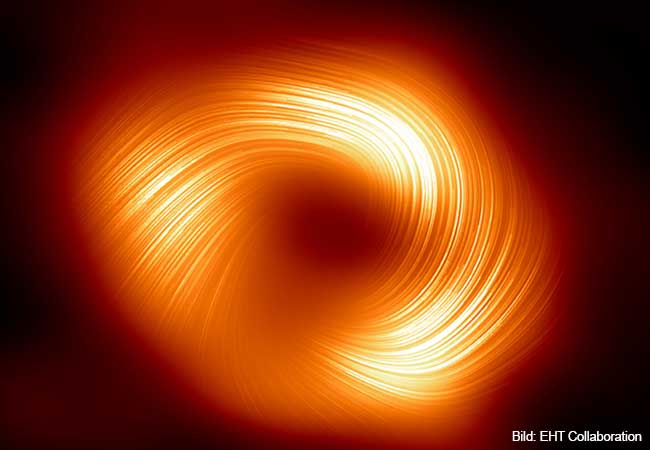A new series of observations by the Event Horizon Telescope (EHT) collaboration measuring the degree of polarization in the emitted light shows that the black hole Sagittarius A* (Sgr A*) in the center of our Milky Way is surrounded by strong, spiral-shaped magnetic fields. Such a magnetic structure is likely produced by the magnetized plasma that is falling onto Sgr A* and is similar to that of M87*, the black hole at the center of the galaxy M87. This important result suggests that all black holes may have strong magnetic fields and that Sgr A*, like M87*, may emit a particle jet that has not yet been revealed by the observations. The team led by Prof. Luciano Rezzolla, Goethe University Frankfurt, was significantly involved in the evaluation and theoretical interpretation of the new measurements.

In 2022, scientists of the EHT unveiled the first image of Sgr A* – which is approximately 27,000 light-years away from Earth – revealing that the Milky Way’s supermassive black hole looks remarkably similar to M87’s, even though it is more than a thousand times smaller and less massive. This made scientists wonder whether the two shared common traits outside of their looks. To find out, the team decided to study Sgr A* in polarized light. Previous studies of light around M87* had shown that the magnetic fields around the gigantic black hole allowed it to launch powerful jets of material back into the surrounding environment. Building on this work, the new images revealed that the same may be true for Sgr A*.
Imaging black holes, especially Sgr A*, in polarized light is not easy, because the ionized gas, or plasma, in the vicinity of the black hole orbits it in only a few minutes. Because the particles of the plasma swirl around the magnetic field lines, the magnetic field structures change rapidly during the recording of the radio waves by the EHT. Sophisticated instruments and techniques were required to capture the image the supermassive black hole.
Professor Luciano Rezzolla, theoretical astrophysicist at Goethe University Frankfurt, explains: „Polarized radio waves are influenced by magnetic fields and by studying the degree of polarization of the observed light we can learn how the magnetic fields of the black hole are distributed. However, unlike a standard image, which needs only information on the intensity of the light, creating a polarization map as the one we have just published is considerably harder. Indeed, our polarized image of Sgr A* is the result of a careful comparison between the actual measurements and the hundreds of thousands of possible images we can produce via advanced supercomputer simulations. Similar to the first image of Sgr A*, these polarized images represent an average of all measurements.“
Rezzolla’s fellow Project Scientist Geoffrey Bower from the Institute of Astronomy and Astrophysics, Academia Sinica, Taiwan adds, “Making a polarized image is like opening the book after you have only seen the cover. Because Sgr A* moves around while we try to take its picture, it was difficult to construct even the unpolarized image,” adding that the first image was an average of multiple images due to Sgr A*’s movement. “We were relieved that polarized imaging was even possible. Some models were far too scrambled and turbulent to construct a polarized image, but nature was not so cruel.”
“By imaging polarized light from hot glowing gas near black holes, we are directly inferring the structure and strength of the magnetic fields that thread the flow of gas and matter that the black hole feeds on and ejects,” said Harvard Black Hole Initiative Fellow and project co-lead Angelo Ricarte. “Polarized light teaches us a lot more about the astrophysics, the properties of the gas, and mechanisms that take place as a black hole feeds.”
Sara Issaoun, NASA Hubble Fellowship Program Einstein Fellow at the Center for Astrophysics, Harvard & Smithsonian and co-lead of the project, says “Along with Sgr A* having a strikingly similar polarization structure to that seen in the much larger and more powerful M87* black hole, we’ve learned that strong and ordered magnetic fields are critical to how black holes interact with the gas and matter around them.”
Mariafelicia De Laurentis, EHT Deputy Project Scientist and professor at the University of Naples Federico II, Italy, also emphasizes the significance of the similarity between the magnetic field structures of M87* and Sgr A*, suggesting universal processes governing black hole feeding and jet launching despite differences in their properties. This finding enhances theoretical models and simulations, refining our understanding of black hole dynamics near the event horizon.
Background: Magnetic fields at the edge of M87’s black hole (2021)
Publications:
(1) EHT collaboration: First Sagittarius A* Event Horizon Telescope Results. VII. Polarization of the Ring. Astrophysical Journal Letters (2024) https://iopscience.iop.org/article/10.3847/2041-8213/ad2df0
(2) EHT collaboration: First Sagittarius A* Event Horizon Telescope Results. VIII. Physical Interpretation of the Polarized Ring. Astrophysical Journal Letters (2024) https://iopscience.iop.org/article/10.3847/2041-8213/ad2df1









